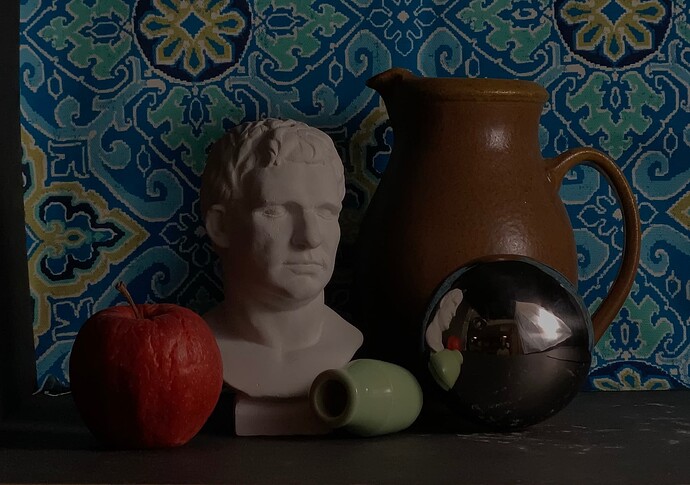Sorry for the delay on this Tim. I have been swamped these past weeks and realize that I really need to hire some help for the Academy. Ugh!
Anyway—let me address the questions as they were first presented here:
- Are there times when it’s easier to paint the specular reflection indirectly, over the diffuse reflection?
I never do this. For me, those specular highlights define a very important value ceiling that I use to judge subsequent values (or colors.) I would argue that putting them off until later would deprive me of a very important piece of functional information.
- If painting directly, are there gotchas with the gradients? I find I have a bit of trouble controlling the chroma as it transitions into the reflection.
There are always “gotcha” moments when dealing with the changes in HVC from one point on a painting to another. To effectively “juggle” physical properties (opacity, pigment “strength”, paint body/fluidity, varied drying/absorption rates, etc…) and perceptual dynamics (brightness and color contrast, adaptation, Mach-banding, perceived hue, chroma and value synergy, etc.) takes a lot of practice. There are no easy tricks or shortcuts that I am aware of or utilize. I handle the colors and values around a specular highlight the same way I handle those darkening halftones as they near a terminator or attached shadow accent.
Generally speaking, I try to include a good range of varied surfaces and forms in my work (I believe the juxtapositions help “sell” the visual, textural experience of each surface.) Pieces like this ( Detail of Lamoraal Vanitas, 14×11″, Oil) have varied spread reflections throughout. The vase is approaching specular—but it is not a “perfect” homogenous, image-creating mirror. There are many surface variations (not to mention distortions due to form orientations.) The skull leans much more toward diffuse, but it still has some semi-isolated highlights that keep it from earning that true Lambertian badge.
Here’s another with quite a few varied hybrids throughout ( Lunch Break II, 11×14″, Oil):
- I also often have trouble making it feel like the specular reflection feel like it’s sitting over the diffuse reflection. It often ends up feeling instead like a change in local color in the diffuse layer. Any tricks for that?
I remember the large “specularish” highlight here taking some time. There were a ton of hue and chroma variations as it moved from the center to the periphery (Detail from Well-played, 13×19″, Oil.)
Honestly, Tim, I don’t think I worried about the highlight “sitting over” the “local surface” as much as I did the communication of the idea that the texture in the highlight, and what was immediately around it, held information that communicated a kinship with the surface elsewhere.
Overall, I think you might just be overcomplicating your conceptual framework. Transitions from hybrid reflections to adjacent areas are really no different than any other A to B transition. It will remain much more difficult than it has to be if your conceptual framework is getting in the way.
I hope that helps a bit. Let me know if there are still some specifics here I could walk you through. (And again, sorry about the delay. I had to wrap up a piece for a Holiday exhibition and the studio had one issue after another that need immediate attention.) 
 . Most of my training in the past amounted to “And then you put the highlights in at the end, and vary the edges”.
. Most of my training in the past amounted to “And then you put the highlights in at the end, and vary the edges”.







